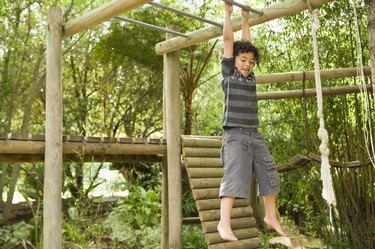
Healthy habits should begin in childhood. Children who grow up with an emphasis on fitness will have the habit for healthy living more deeply ingrained in them. The Centers for Disease Control and Prevention recommends that children and adolescents get at least one hour of physical activity every day. Many things count as physical activity; however, if you are unsure if an activity should count, check the heart rates of your children to see if they are exerting themselves enough.
Taking a Pulse
Video of the Day
Use your index, middle and ring fingers to take your child's pulse. Place your fingers either on your child's wrist just under the base of her thumb or on one side of her windpipe. Press lightly until you feel the blood pulsing. Using a watch or clock with a second hand, count the number of beats of your child's heart for 10 seconds. Multiply the number by six to determine your child's heart rate.
Video of the Day
When to Take a Pulse
In order to determine if your child's physical activity, such as playing on playground equipment, should be counted as exercise, plan to monitor his heart rate next the time he plays at the park. Prior to leaving the house, record his resting heart rate. After arriving at the park, allow your child to play for 10 minutes, then take his pulse. It is a good idea to go to him and start counting heart beats as soon as you can so his heart rate does not have a chance to slow as he walks over to you. Have him return to playing and check his heart rate every 10 minutes, recording the results.
What the Heart Rate Should Be
Your child's heart rate is dependent upon her age. A child of 3 or 4 should have an exercising heart rate of around 137 beats per minute. By 5 to 7 years old, the heart rate drops to just 133 beats per minute. From 8 to 11, it is even lower, 130 beats per minute. Finally, in adolescence, the exercising heart rate is significantly lower. A 12- to 15-year-old only needs to get her heart rate to 115 beats per minute when exercising.
Influencing Heart Rate
After monitoring your child's heart rate during physical activity, you can take steps to help mold his activity into that which qualifies as exercise. If your child's heart rate is on the high end, interrupt his play frequently with breaks for water or a brief chat. If your child's heart rate is on the low end, encourage him to play harder. Challenge him to a race or a contest. Try timing him and encouraging him to do something faster.
- Centers for Disease Control and Prevention: Physical Activity for Everyone: How Much Physical Activity Do Children Need?
- Cleveland Clinic: Heart and Vascular Health and Prevention: Pulse and Target Heart Rate
- Cleveland Clinic: Health Information: Your Pulse and Your Target Heart Rate
- American Council on Exercise: Heart Rate Zone Calculator
- Horizon Blue Cross Blue Shield: Target Heart Rate for Children